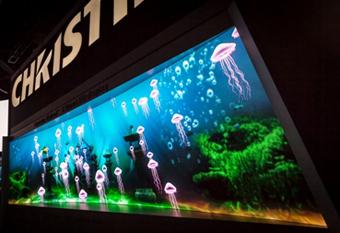There was a time when digital signage meant simply a flat screen—much like your desktop version—displayed throughout businesses, in retail environments, and virtually anywhere the viewers required information or direction.
Today digital signage is becoming even more ubiquitous. However its design and content options have benefitted from several upgrades.
“The latest interactive digital signage has to provide more than simple choices from a fixed menu for customers,” says Andy Clipsham, senior product manager at Christie®, a company specializing in visual, audio, and collaboration solutions. “It has to engage them in a more dynamic, immersive, and intuitive way—to the point where customers can personalize the content to their tastes.
“This includes incorporating social media and other communication tools that allow the customer to ‘talk’ directly to the content.”
He adds that digital signage has now become more acceptable, and perhaps even expected, in locations everywhere.
In addition, over the last ten years, the hardware costs have come down, making owning a system much more affordable to smaller businesses.
“The evolution of digital signage over the past ten years has been nothing short of spectacular,” says Clipsham. “LCD flat panel and LED displays, sophisticated content, interactivity, and customer engagement are among the most significant changes.”
When examining digital signage, one of the first concerns that comes up relates to content: If digital signage is now “everywhere,” the content may be at risk for being repetitive, stale material, especially if clients aren’t informed about content options.
One company tackling this issue is Creative Margin, a content company specializing in digital signage that provides services to help clients put together a strategy and create new, engaging content.
Founded in January 2014, the company identified a market need for solutions that allow clients to really “get their arms around digital signage,” as Founder and Vice President Matt Krebs puts it.
“We see, over and over again, end-users who have invested a great deal of time and money in purchasing software and hardware and mount these screens around their business,” he says. “These screens hang there, and best case, they play the same content that was created for them when first installed.
“Or worse, maybe someone put a PowerPoint presentation together and slapped it up on the screen and there’s letterboxing, it’s barely readable, and/or it’s outdated. Or maybe the screens are turned off in a corner, which is not out of the ordinary.”
His company’s strategy is to emphasize that digital signage is now affordable (keeping in mind the historically high cost of content)—and can be quite engaging.
“When you lower that barrier to entry for the upfront investment, it’s easier for customers to grasp the inherent value propositions of digital signage—ease of updates, lower cost of update, day parting to cater to different audiences, interactivity, etc.,” he says. “Customers will be helped much more by an embedded partner that demonstrates how each dollar invested can align with their initial vision for the signage and contribute in some way to profits.”
Richard Ventura, vice president of Business Development at provider NEC Display Solutions, stresses that digital signage content has evolved significantly from its early days of using lots of words, videos, animation, pictures, and information. “It’s all about emphasizing quality and impact now,” he says. “Content needs to truly reflect and enhance one’s brand and message in a simple and efficient way.”
The range of creative options for presenting content makes this media exciting.

For an installation at Cleveland Museum of Art, Christie incorporated its MicroTiles® high-resolution digital “canvas” and its Interactivity Kit to create the Collection Wall. Spanning 40 feet long-by-5 feet high, this interactive digital display wall contains 150 digital tiles. Upon approaching the wall, visitors can locate the art they’d like to see at the museum, and download personalized tours to their mobile device.
Serving multiple purposes, this digital display is not only a piece of art itself but also becomes a wayfinding device and communications tool.
“Rather than simply a traditional, static exhibition, the museum now has interactivity that helps people see, appreciate, and understand the art that is there,” says Clipsham. “From a distance, the wall has a real ‘wow factor,’ but it becomes a completely different experience when patrons go up and interact with it.”
When working with clients on content, Christie doesn’t advise a DIY approach.
“Unless they possess an exceptional level of artistic and technical expertise, they could severely limit the effectiveness of the signage or fail to take advantage of the technology available to them,” says Clipsham.
There are simple, everyday applications for digital signage that allow for customization, either by the client or a content management process developed in conjunction with the client’s needs. What is critical is that the client has the budget and resources to manage the content they request.
In other words, animation is ideal, but having a team in place that can fix any bugs or issues that come up in the presentation is critical to the success of the display.
While digital menu boards are proving more common to come across these days, most implementations are static imagery that rotates throughout the day. There’s a reason for this.
“Restaurants and retailers are adopting a less-is-more aesthetic,” says Ventura. “If there are too many things displayed on the screens, it tends to confuse customers and possibly delay orders.”
Krebs offers some ideas for keeping even the simplest content fresh:
“Even if it’s just an image on a menu board, that image should change at particular times of day, or maybe a region of the sign shows a food special until the POS system shows that item as ‘sold out,’” he says.
Krebs emphasizes that, no matter the business scope or the size of the display, sophistication is still expected.
“The reason there are over 600 software [programs] out there is that digital signage does require a more purpose-built toolset for creating and managing content than PowerPoint provides,” he says.
As there continues to be a market appetite for digital signage that serves a diverse range of business needs, Krebs points out that there are specific market tracks where sales seem to be increasing. With the explosion of smartphones, many clients seem to prefer smaller touchscreen devices over the large kiosks that were popular several years ago.
“What customers are looking for now is cheaper software options that can run on tablets available in stores or off service providers such as Amazon, Apple, Samsung, Acer, and others,” he says.
And of course, users are interested in connecting their smartphones to external devices and interacting on topics of relevance to them.
Krebs points out that technologies such as Near Field Communication (NFC), Bluetooth Beacons, and QR Codes are all on the frontier of this changing landscape, allowing the user to tap, activate, or scan their phone to connect with content they are viewing on a digital sign.
“There’s a realization that if a company is going to invest in large format digital signage, there ought to be a way for users to take information with them on their phone” he says. (Note: Touchscreens may lean towards the high end for smaller businesses to incorporate into digital signage.)
And for the technology-savvy out there (we’re talking code), there’s been a shift to HTML5 for the code to run the user interface.
“This is a departure from the incumbents in the industry, who have proprietary applications (and expensive teams of developers to support) running on Windows®,” says Krebs. “HTML5 allows for a more open-source approach, easier reuse of previous work, and ultimately better stability all at a significant discount because it’s Cloud-based and works on any device that has an Internet browser.”
Working on larger projects that have many integrated components demands a robust set of resources and skill sets.
“We understand that every digital signage project offers a new set of challenges, including the physical environment, budget constraints, learning different technologies; interactive functionality; and designing and maintaining the display network,” says Clipsham.
In considering a digital sign supplier, Clipsham advises working with firms that have a demonstrated track record, especially since there are so many moving parts to this process.
“From the design and content creation, to the selection of the best technology for the job, to the physical process of integrating and installing the signage, there are many parts,” he says. “Each display wall project varies in size, complexity, and application, requiring different levels of integration.
“Bringing in experts who can offer all the comprehensive services under one roof can save a lot of trial and error, while also offering custom training and service programs.”
When choosing a system, Creative Margin is keen on strategy and planning as a first step.
“More often, customers buy either the wrong tool or too much tool for the kind of digital signage they need,” says Krebs. “Remember more features often means more difficult to learn and support.”
The question that many professionals ask continues to beckon: Will digital signage replace static, traditional signage?
“I think it depends on the frequency of updates,” says Krebs. “Let’s say a restaurant only updates their menu once a year—that may not pay off to replace with digital signage.
“But if a display is getting updates more than once a quarter, you’ve got a pretty good argument to allow that to be updated at a very low cost from a computer.”
By Lori Shridhare
Photos (top to bottom): Christie, Christie, Creative Margin.











